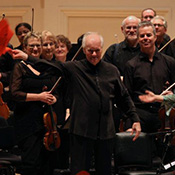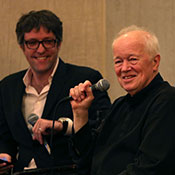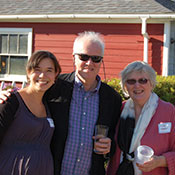
Edo de Waart’s Exit Interview
David Lewellen
PUBLISHED
Tagged Under: 2016.17 Season, Conductor
After eight years, Music Director Edo de Waart still isn’t sure if the Milwaukee Symphony recognizes its own excellence.
“I hope I have helped give the orchestra that confidence — ‘yes, we are good,’” de Waart said this week, just before rehearsals began for Mahler’s Symphony No. 3, his farewell performances with the orchestra as music director. “Often I have said to them, ‘I don’t know if you know how good you are,’ but when I come back after being away for a while, I really hear it.”
Considering his tenure here, de Waart thought further back to his time as a young conductor working with the Cleveland Orchestra when it was led by the legendary George Szell. “An orchestra should work like a good engine, where all the parts perform,” he said. In Cleveland, every player had to fit into the ensemble, “and in my own way I’ve tried to do that here. We’ve been very lucky to get some very good players.”
What makes a good MSO musician? “Musical intelligence, a knowledge of how something needs to be played. And being a good fit, one thread in the tapestry we weave. I don’t like prima donnas; they don’t belong in our orchestra. We are a team. And in the way they play, you can see if someone is a vain person or a good musician.”
De Waart spoke fondly of the orchestra’s three-year cycle of the Mozart-da Ponte operas. Coming off the financial crisis of 2013-14, the symphony made a three-year commitment to open its seasons with semi-staged operas, beginning with Don Giovanni in September 2014. One reason de Waart cut back on opera conducting, he said, was because he was tired of stage directors imposing their own ideas on a piece — but James Darrah, who staged Don Giovanni in Milwaukee, “was extremely good in thinking from the music. I found a good mate in him, and a good cast who loved working with him.”
The creative team also planned the order of the works carefully, placing Cosi Fan Tutte, the least appreciated of the three, in the middle, and concluding last fall with the beloved The Marriage of Figaro.
Although de Waart called Mozart “a sun by himself,” he pointed to Beethoven and Mahler as the core of the symphonic repertoire. “Every orchestra where I’ve been music director, those are the two pillars. It’s like a great book that you can read five times and still find things that you missed the fifth time.”
Among contemporary composers, de Waart has a special relationship with John Adams, whom he got to know decades ago when he led the San Francisco Symphony and Adams lived nearby. Another highlight of de Waart’s time in Milwaukee was the series of concerts at the Pabst Theater in 2014 that paired Adams pieces with Beethoven pieces. “He knows how to write for the orchestra,” de Waart said of his friend. “And he has a sense of humor. He’s self-deprecating, but he knows he’s a good composer.”
Conducting a brand-new piece is often easier than conducting a classic, de Waart said, without the weight of history pressing down — “unless the composer doesn’t know how to write for the orchestra, or runs out of ideas after 12 minutes.”
De Waart will continue to be a busy international conductor, but he hopes to scale back from his current 30 weeks of work a year to 15 or 20, while maintaining his home in Madison. He will be 76 in a few weeks, and many conductors have done great work well into their 80s. “I would like to keep going, if I’m healthy and it doesn’t cost me my life in jet lag,” he said. “I love what I do, but I could still be home and rest.” He has agreed to serve as Milwaukee’s conductor laureate, leading two weeks of concerts next season and auditioning musicians to fill open spots. And he muses about someday getting one more chance to conduct Wagner’s Parsifal or Tristan und Isolde.
But for the city of Milwaukee, he said, “it’s so important for the orchestra and its future to have their own hall. We need everyone to help make that happen. They will finally hear how good the orchestra can sound.” Recalling the orchestra’s trip to the acoustically renowned Carnegie Hall in 2012, he said, “That should be a trip they make every two or three years. And that might come. The sky’s the limit.”



